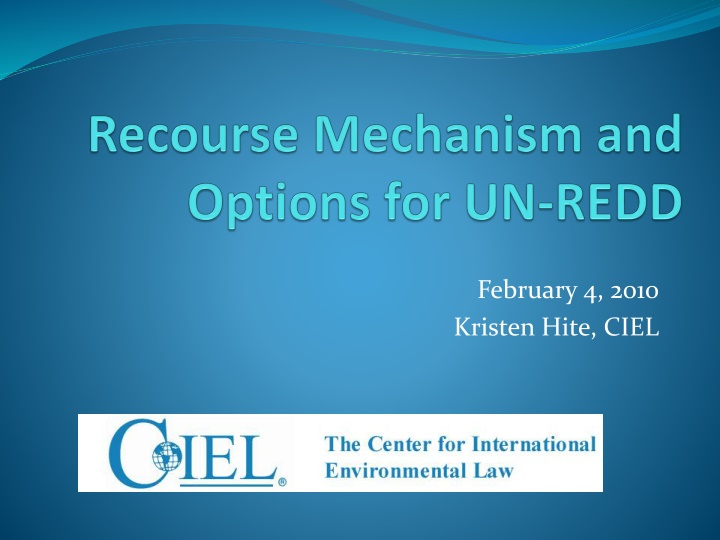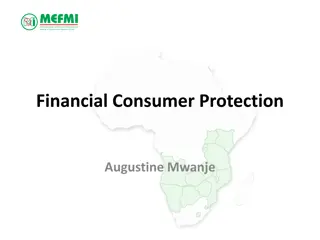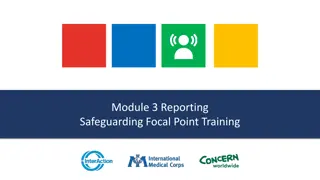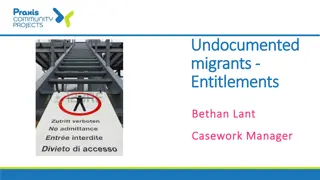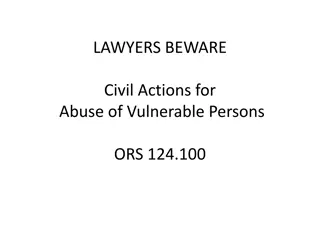Recourse Mechanisms
Recourse mechanisms address adverse impacts from specific activities through case-by-case processing of complaints, ensuring key principles like independence and effectiveness. Various functions and scope considerations contribute to accountability and evaluation of claims in international obligations context.
Download Presentation

Please find below an Image/Link to download the presentation.
The content on the website is provided AS IS for your information and personal use only. It may not be sold, licensed, or shared on other websites without obtaining consent from the author.If you encounter any issues during the download, it is possible that the publisher has removed the file from their server.
You are allowed to download the files provided on this website for personal or commercial use, subject to the condition that they are used lawfully. All files are the property of their respective owners.
The content on the website is provided AS IS for your information and personal use only. It may not be sold, licensed, or shared on other websites without obtaining consent from the author.
E N D
Presentation Transcript
February 4, 2010 Kristen Hite, CIEL
What is a recourse mechanism? A recourse mechanism considers and addresses adverse impacts resulting from case-specific activities. Complaints may be based on specific harm and/or violations of specific obligations and procedures. Complaints are processed and solutions are considered on a case-by-case basis.
Recourse Mechanism: Key Principles Accessibility Independence Credibility Transparency Efficiency Effectiveness How do we ensure independence and also retain authority for effective implementation? How do we respect sovereignty and also avoid gaps in implementation of obligations?
Possible Mechanism Functions Reporting: UN Special Rapporteurs Fact-finding: World Bank Inspection Panel Arbitration: NAFTA Chapter 11 ICSID/UNCITRAL Litigation: Inter American Court of Human Rights Mediation: IFC Compliance Advisory Ombudsman Donor Accountability: National Human Rights Institutions for OECD countries.
Scope: activities, obligations, complainants Action: evaluator, remedies, implementation Process: submissions, appeals, accessibility
SCOPE: What obligations apply? Consider rights, standards, rules, policies, and procedures related to international obligations. UN-REDD adopts a rights-based approach to its activities. International obligations apply at different levels: International: human rights and other obligations National: human rights, UN-REDD guidance Sub-national: States and private actors still have international obligations
Who can evaluate claims and ensure accountability? Three options for UN-REDD: (1) Specify the obligations of UN-REDD actors to resolve complaints, (2) Refer complainants existing entities competent in the subject matter, and/or (3) Hear the complaints directly NOTE: options are not mutually exclusive
Specify Obligations Principle: resolve disputes at most direct level possible. National programme designs should consider how to ensure accountability for obligations: NPs should consider process to ensure obligations and access to justice at the sub-national and national level. National programmes should recognize process at the international level to consider complaints not effectively resolved at the national level.
Referring complaints: options UN Human Rights System Utilize UN agency accountability mechanisms MDTF Office UNDP Evaluation Office Utilize partner accountability mechanisms World Bank Inspection Panel Utilize donor accountability mechanism OECD National Contact Points
Customizing an accountability mechanism for UN-REDD Issue findings of fact relating to alleged violations of obligations. Offer mediation services Offer formal adjudication services Offer appellate services for project-based or national level adjudication Incorporate compliance indicators into MRV.
Types of remedies available Issue findings of fact Provide compensation for harm Offer remediation activities to restore to earlier condition Injunction to suspend or halt activity Sanction: punish activity to communicate unacceptability of action. Precautionary measures to avoid future impacts or harm.
Incorporate State obligations into the NP document Elaborate procedures for a new UN-REDD mechanism Ensure that information and obligations related to the mechanism(s) are shared with potentially impacted communities. Consider complaints at the project level Develop effective remedies for violations Include compliance indicators in MRV process Incorporate lessons learned
Incorporate State obligations into the National Programme document The Policy Board could approve operational guidance that includes a requirement to list the relevant treaties and other national obligations applicable to activities taken pursuant to actions proposed in the NP. Develop list of obligations prior to national validation meeting in order to build understanding of obligations and enable transparent disclosure of information. NP document should describe obligations and recourse options at national and international levels.
Elaborate specific procedures for a new UN-REDD mechanism Possible options for specific functions: Issue findings of fact relating to alleged violations of obligations. Offer mediation services. Refer some complaints to subject matter experts. Secretariat could consider complaints One of the UN Agencies could host an independent office. Refer complaints and propose actions to the Policy Board
Project developers should consider complaints at the project level. As a supplement to national and international dispute resolution procedures, the Policy Board could require UN-REDD activities undertaken at the community level to include a project-level mechanism to address project-level complaints. Some complaints will not be able to be effectively resolved at the project level due to differences in power, culture, access to information, and understanding of obligations.
Develop effective remedies for violations Agree on rules at outset, do not wait until conflict arises. Options include declaration (issue findings of violation), injunction (halt violation), compensation (pay for harm caused by violation), sanction (punish violation), and/or restitution (restore to pre-harm state). NP document should recognize that programme activities and/or support can be suspended when violations are sufficiently serious.
Include compliance indicators in MRV process Develop indicators related to specific obligations Monitoring, reporting, and verifying compliance with obligations can help resolve disputes. MRV requirements can help address due diligence obligations. In theory, it may even be possible to incorporate some of the reporting functions of human rights mandate holders.
Incorporate lessons learned Any national or international grievance mechanism or expert reviewing claims could have an annual reporting requirement to the policy board. Annual report could include complaints received, decisions taken, lessons learned, and recommendations for future action.
More Information Resources: Database of grievance mechanisms: http://www.baseswiki.org World Bank Inspection Panel: http://www.worldbank.org/inspectionpanel UN Human Rights Bodies: http://www.ohchr.org/EN/HRBodies/Pages/HumanRi ghtsBodies.aspx CIEL website: http://www.ciel.org/ Questions? Email khite@ciel.org
